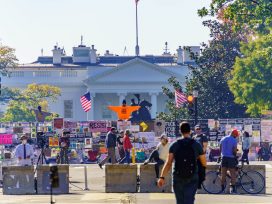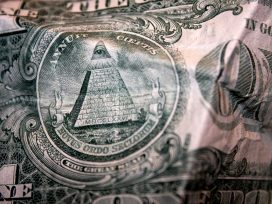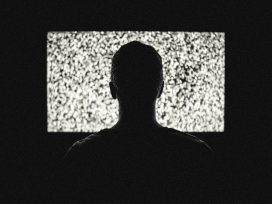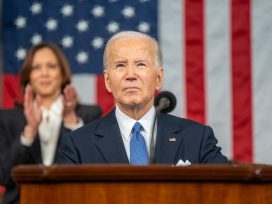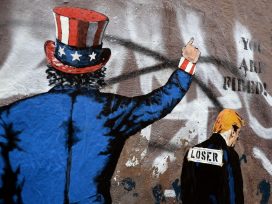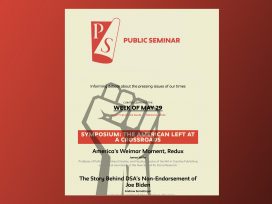In the last two years, conspiracy theories have become integral to American political discourse. Politicians have shaped priorities and policy around conspiracy claims, and the mainstream media has been all too happy to highlight conspiracy theories in their coverage. Polls show that Americans hold many conspiracy beliefs in the aftermath of the 2016 election. For example, 50 per cent of Democrats believe that Russia hacked the voting machines despite having no evidence of such. That Americans believe in conspiracy theories is nothing new. That conspiracy theories have become so prominent in our political rhetoric is.
Conspiracy theories have always have found a home in the United States. Colonists burned ‘witches’ at the stake, believing they were conspiring with Satan. Early Americans later separated from the British King partially out of concerns of a conspiracy by the crown. A long conspiracy narrative to document this conspiracy is written into the nation’s Declaration of Independence. The American Constitution’s main feature – separation of powers – is an effort to quell any conspiracy by one branch of government or another.
Since the passage of the Constitution, Americans have imputed conspiracy theories to virtually every group (the British, French, Spanish, Bavarian Illuminati, Freemasons, Slave Power, Abolitionists, Catholics, Jews, Mormons, Muslims, communists and capitalists, to name just a few) and to every major event (assassinations, elections, plane crashes, moon landings and untimely deaths, among many others). Whether we are arguing over major policy issues such as health care, environmental protection, or election integrity, or less important matters such as bicycle sharing programs, conspiracy theories crop up to warn of hidden plots and impending danger. It is difficult to know if the United States is more influenced by conspiracy theories than other nations (social scientists don’t yet have enough data to answer this question), but it is enough to say that Americans are no stranger to conspiracy theorizing historically or contemporarily.
More so than any recent election, 2016 was plagued by allegations of schemes and skullduggery. Conspiracy theories became the grounds on which issues were argued and candidates were judged. Either candidates were accused of engaging in far-reaching conspiracies, or they were accused of propagating dubious conspiracy theories. The election’s aftermath has seen a continuing wave of conspiracy accusations – mostly surrounding a supposed illicit alliance between Presidents Trump and Putin. These conspiracy theories beget more conspiracy theories and they shape politics and policy.
Most recent accounts of conspiracy theorizing in the media have adopted an alarmist tone – suggesting that Americans have ‘lost their minds’ and that we have entered a ‘post-truth world’. But what is the reality? It is easy to be discouraged by the on-going conspiracy rhetoric, but the social scientists who study conspiracy theories can offer us a very different story – one which, despite the apocalyptic notions of a post-truth world, offers a narrative of stability rather than of impending doom.
When it comes to the amount of conspiracy theorizing plaguing the public, journalists always find it easy to ring the alarm bell. The New York Times recently described American politics as ‘deeply infused with paranoia and distrust’. It’s easy to be alarmed by such headlines telling of a decent into post-truth conspiracy mania, but when put into context, fears of conspiracy theories are overdrawn and much too frequent. In 2011, the New York Daily News declared ‘It’s official: America is becoming a conspiratocracy’. Seven years earlier, the Boston Globe suggested that 2004 was the ‘golden age of conspiracy theory.’ In 1991, the Washington Post asserted that we lived ‘in an age of conspiracy theories’, but changed its mind in 1994, when it claimed that Bill Clinton’s first term ‘marked the dawn of a new age of conspiracy theory.’ In 1977, the Los Angeles Times declared that America had hit the high-water mark and were ‘as conspiracy prone in our judgments as the Pan-Slav nationalists in the 1880s Balkans’. I have no idea what was going on in the 1880s Balkans, I can only assume that there were lots of conspiracy theories. Going back to the assassination of JFK, the New York Times was sure in 1964 that conspiracy theories had ‘grown weedlike in this country and abroad’.
If the headlines are to be takes seriously, conspiracy theorizing in the US has always been at an all-time high, and is only getting higher. At least 150 per cent of people should be hard-core conspiracy theorists, with daily runs on the grocery store for tin foil. Journalists and commentators in the above instances simply relied on their own impressions without any data or point of comparison. An exploration behind the headlines – into the psychology and politics that drive conspiracy theorizing – might better contextualize the role that conspiracy theories, fake news, and hyper-partisanship are playing in American politics right now.
A conspiracy within a conspiracy: The DNC leaks
It is true that, in 2016 conspiracy theories became so frequent and at times so bizarre that mainstream news outlets were unsure of how to cover them. For example, Donald Trump’s assertion that Senator Ted Cruz’s father had taken part in the assassination of JFK in 1963 led the Washington Post to proclaim in exasperation, ‘How on earth is the media supposed to cover Trump’s wacky JFK–Cruz conspiracy theory?’ While Trump deserves a fair share of the credit for elevating conspiracy theories into the electoral discourse, he can’t take all of it. There was fertile ground. And, there were other high-profile politicians trafficking in conspiracy rhetoric.
Political discourse over the last two decades has been riddled with conspiracy theories. Bill Clinton’s impeachment was about a vast conspiracy as much as it was about his sexual improprieties. Post 9/11 rhetoric was often driven by conspiracy theories suggesting the Bush Administration murdered thousands of Americans or manufactured pretense for a war just for oil. The Obama Administration was held in equally low regard: Obama was accused of being a foreign usurper, of blowing up the Deepwater Horizon Well, killing the kids at Sandy Hook, and orchestrating a military take-over of Texas.
Obama’s second term was particularly fertile ground for conspiracy theories. 2013 started with a series of scandals involving Benghazi, the wiretapping of journalists and their families, and the IRS targeting of conservative groups. These scandals dragged on through the 2016 campaign and primed the public for an election filled with allegations of fraud, corruption, and cover-ups.
The most prominent conspiracy theory now is that Trump conspired to relieve sanctions if Russia were to help the Trump campaign beat Hillary Clinton. Russia supposedly obliged by hacking into the Democratic National Party’s emails. These emails, which painted the DNC in a negative light, were released right before the Democratic convention in which Clinton was to be nominated. The leak mattered because the contents suggested that the Democratic Party rigged the primaries against Bernie Sanders, Clinton’s opponent. This of course alienated the more liberal wing of the Democratic Party, perhaps pushing some Sanders supporters to vote for Trump and others to stay home. It became later known that Donna Brazille, who was both a CNN analyst and vice-chair of the DNC, had fed the Clinton campaign debate questions in advance. She initially lied about her role, but was fired and eventually admitted to her wrongdoing. In essence, the Trump conspiracy theories assert that Russia conspired with Trump by exposing an actual conspiracy within the DNC.
The conspiracy theories swirl so fast it is difficult to keep up. During the primaries, Trump was accused of being a Clinton agent whose task was to destroy Republican chances at beating Clinton. Once he won the election, that conspiracy theory went away and was replaced with the theory that Trump conspired with Putin to illicitly win. Trump claimed throughout the campaign that the election would be rigged against him; now he is accused of doing the rigging himself. Immediately after the election, far-left Green Party presidential candidate Jill Stein raised more than seven million dollars, supposedly to investigate irregularities in the voting machines in several states. These irregularities were supposedly the result of Russian hacking. No irregularities were found, and a recount did not ensue. Despite this, Stein is now accused of being a Russian agent.
What is a conspiracy theory?
Just the term ‘conspiracy theory’ has been known to stop fruitful conversations in their tracks. It can imply that an idea is without merit. Beyond this, ‘conspiracy theory’ is often used to refer to a range of concepts – ESP, Bigfoot, Loch Ness Monster, ghosts, aliens, etc. – that go far beyond what I reference here. Let me get the perfunctories out of the way with a brief discussion of what I mean when I say ‘conspiracy theory’.
A ‘conspiracy’ is a small group of powerful persons acting in secret for their own benefit and against the common good. In my usage, conspiracies are large scale assaults on our bedrock institutions and practices. Conspiracies are real and happen all too often. Likely, there are many taking place right now. Prime examples are Richard Nixon’s crimes against the Constitution and subsequent cover-up, known as Watergate; the Iran-Contra affair, in which arms were illegally traded for hostages; and the Tuskegee experiments, where doctors injected syphilis into the eyes and spines of African-Americans and Guatemalans without their consent. It is important to acknowledge, however, that just because conspiracies happen, not all conspiracy theories are true.
‘Conspiracy theory’ refers to an accusation, which may or may not be true, that posits a conspiracy. Conspiracy theories are not concerned with small crimes (e.g. a temptress and her lover devise to kill the cuck husband), but rather with actions that tear at the very fabric of our society. These might include global financial scams, mass brainwashing, depopulation, and interference with democratic institutions and processes. The theory that the CIA killed JFK is a conspiracy theory; so is the notion that climate scientists faked data to precede a socialist take-over. I am obliged to state here – contrary to many conspiracy theorists – that the term ‘conspiracy theory’ was itself not created as part of a CIA conspiracy to hinder scepticism in the aftermath of the Kennedy assassination.
There are millions and millions of conspiracy theories. If you want proof that the internet is not fertile ground for conspiracy theories, just spend a few days on Twitter. Thousands of conspiracy theories will appear each day, but the vast, vast majority will disappear into the night having generated little interest and few followers. It is only a select few that amass a measurable number of believers and any degree of staying power.
Philosophers have invested considerable energy into defining the difference between conspiracies and conspiracy theories. Some of this work focuses on delineating the conspiracy theories which are warranted – those which are likely to be true – from those which are most likely false and should be abandoned. There is a great deal of disagreement on this front, largely because conspiracy theories are non-falsifiable. Given that we expect evidence to be hidden and red-herrings to abound, proving a conspiracy theory true or false is exceptionally difficult. But for the purposes of my usage, the difference between conspiracy and conspiracy theory rest on what is most likely true as determined by our appropriate knowledge-generating institutions. I refer to Watergate as a conspiracy because courts held trials, Congress held hearings, perpetrators went to jail, and the relevant evidence is out in the open for all to see. Theories about JFK’s assassination – whether they implicate the CIA, then Vice-President Lyndon Johnson, Cuba, or the Soviet Union – are conspiracy theories because the appropriate institution in this instance, the Warren Commission, determined that one lone assassin, Lee Harvey Oswald, acted on his own and without direction.
Experts, scientists, and officials could be (and are) wrong from time to time, but the best path to truth in those instances is more experts, scientists, and officials rather than more conspiracy theories. Conspiracy theories and theorists can occasionally do good by promoting scepticism and encouraging scrutiny, particularly of the powerful; but as a pathway to truth, conspiracy theories are generally terrible when compared to our mainstream knowledge-generating institutions. Conspiracy theory ‘methods’, if they exist, have never been shown to be reliable.
Nonetheless, if one wants to challenge mainstream wisdom, conspiracy theories are an excellent rhetorical device for doing so. If the evidence is not in one’s favour, if one’s experts are outnumbered and outmatched, then a conspiracy theory can easily explain away shortcomings and change the grounds of debate. Climate change deniers and creationists typically reach for conspiracy theories to explain why their ideas are not discussed in the mainstream, not included in serious scientific journals, and not endorsed by a consensus of scientists. A conspiracy theory can change the tenor of the debate so that the onus shifts to mainstream scientists and institutions to prove there is no conspiracy, rather on the science deniers whose ideas offer sparse or dubious evidence. In this way, conspiracy theories can act as a disruptive political mechanism.
Much like ‘conspiracy theory’, ‘conspiracy theorist’ is also a freighted term: a few brave souls wear it as a badge, but most would recoil if called one. The term could refer to anyone who believes in a conspiracy theory – which would be every American – or it could be used to refer to a subset of believers, perhaps those who create or propagate conspiracy theories, or those who have a belief system that is comprised largely of conspiracy theories. I favour the latter usage.
How we conceptualize conspiracy theories has a bearing on how we think about them and how we might choose to address them. The conceptual take-away is this: conspiracy theories are dubious ideas that could be true, but probably aren’t. Despite this, everyone partakes in conspiracy theorizing from time to time, and some conspiracy theories flourish despite a dearth of evidence. There are two sides to the ledger, of course: sometimes conspiracy theories shed new light on a subject; but usually they leave adherents shadowed in ignorance. If conspiracy theories are so dubious, why do so many people believe them?
People rarely adopt ideas they believe are false. People believe things because they assume those things are true. This is one reason why it is so difficult to discuss religion or politics – people have a set of beliefs and despite any evidence to the contrary, they are convinced those beliefs are correct. Similarly, conspiracy theories often leave little room for negotiation. As much as you might think that beliefs in faked birth certificates, controlled demolitions, or second shooters are unevidenced and irrational, the people that have adopted those beliefs are convinced of their veracity and of their own even-minded evaluation of the ‘evidence’. This matters in democracies: if we are going to call on citizens to make decisions which will be backed by force, then we should want citizens to have the most accurate view of reality possible and to reason as rationally as possible. My research into conspiracy theories suggests that many citizens’ views skew far off of reality and that their reasoning is largely biased by socialized worldviews.
Why do people believe in conspiracy theories?
The most appropriate way to conceive of conspiracy theories is as political opinions. The simplest way to understand how political opinions arise is as the sum of a piece of new information coming in and being laid on top of an existing predisposition that helps us interpret that new information. For example, during the last month of the Obama administration, the final Obama era jobs report came out. The numbers showed national unemployment holding steady at around 4.7 per cent. Democrats looked at the number and thought, ‘Great job, Obama!’ Republicans looked at that same number and thought, ‘that number isn’t picking up on what’s really going on out there. And worse, that number may be faked!’ Same information, but two very different interpretations.
Elections results and party control have an effect on this too. Before Trump won the presidency, Democrats has a very positive view of the economy; Republicans, on the other hand, had a more sour outlook. When Trump was elected, opinions reversed: Democrats began to sour on the economy while Republican views improved dramatically. The economy has not changed much in the last few months, nor has it changed differentially for Democrats than it has for Republicans. In short, our opinions are shaped by our underlying worldviews and suffice it to say it’s unwise to assume that our political views are derived from an even-handed assessment of facts.
The most important worldview that drives political opinions in the US is partisanship, and American parties are like tribes. Americans are socialized into having an attachment to a party and once solidified these attachments tend to stick for life. Partisans feel a sense of belonging to their party label and likewise, many also feel a disdain for the opposing party. Once Americans hit middle age, they tend to vote for the same party over and over. So, while campaign coverage in the United States makes it seems as though many Americans are making up their minds about candidates, or switching back and forth between parties, the truth is that because underlying dispositions such as partisanship are stable, partisans’ views and behaviours are more stable than the news often lets on. Stories about stability don’t attract as many clicks.
Just as a mother would never believe her son a killer, even when presented with fingerprints on the smoking gun, partisans rarely believe their own party has committed a wrong. Partisanship guides the direction that people point their fingers. Republicans believe that Democrats, labour unions, socialists and communists are conspiring. Democrats on the other hand believe that Republicans, corporations, and the wealthy are conspiring. Most of the time, conspiracy theories are just a new mask for old partisan critiques.
Social psychologists converged around the idea that beliefs in specific conspiracy theories tend to derive from a predisposition toward conspiracy logic – I refer to this as conspiracy thinking. Whereas people might believe that they believe a particular conspiracy theory because they think it is true, or at least well-evidenced, social scientists argue that conspiracy beliefs are little more than the conclusions of biased minds. We all have a friend (or worse, family member) who believes every conspiracy theory they encounter – it can’t be that this person has stockpiled good evidence for their beliefs, rather it’s more likely that they are just predisposed to accept conspiracy theories more so than other explanations.
Perhaps the most important study on the topic shows that conspiracy theorists who believed Princess Diana had been killed by the royal family also believed she was still alive and in hiding; those who believed that Osama bin Laden had been killed before the Navy Seals got to him also believed he was still alive. That conspiracy theorists were willing to believe contradictory narratives suggests that it’s not evidence of a particular plot that drives conspiracy theorists, but rather an underlying disposition towards seeing events and circumstances as the product of conspiracy. People that think very strongly in conspiratorial terms need little evidence to suspect a conspiracy – while those who do not think very strongly in conspiratorial terms need much more evidence. Think of this as a continuum rather than a dichotomy: most people are somewhere in the middle. Education and income are good predictors of how much people engage in conspiracy thinking; the poor and uneducated are more likely to think in such terms while the educated and wealthy are less likely to do so.
When we put partisanship and conspiracy thinking together, we end up with a ceiling for partisan conspiracy theories that tops out at about 25 percent. The reason: in order for someone to endorse a partisan conspiracy theory, they must be both inclined to believe in conspiracy theories and be willing to accuse the villain in the particular theory. ‘Truther’ theories that accused the Bush Administration of complicity in the 9/11 terror attacks plateaued at about 25 per cent – Republicans and people resistant to conspiracy logic were not going to believe this theory. The same goes for the ‘Birther’ theory, that Barack Obama faked his birth certificate – this also peaked at around 25 per cent because it could only persuade conspiracy minded Republicans. The good news is that 75 per cent of the country disavows each theory; the bad news is that 50 percent endorsed one of the two.
Conspiracy theories are for losers
Conspiracy theories are, at their core, about power – who has it and what they are doing with it, especially when no one is looking. Conspiracy theories always accuse a villain presumed to be immensely powerful. Rarely do conspiracy theories accuse the powerless, poor, or crippled. It makes perfect sense, then, that if conspiracy theories are about the machinations of the powerful, then conspiracy theorizing would track actual power. The evidence shows this is the case.
When a Republican is in the White House, conspiracy theories tend to accuse Republicans, the wealthy, and corporations; when a Democrat is in the White House, conspiracy theories tend to accuse Democrats, socialists, and communists. We have seen this pendulum swing back and forth with power over the last few decades. During the Bush Administration, Democrats were the ones pushing conspiracy narratives about 9/11, Bush, Cheney, Haliburton, Blackwater, and so on. This switched as soon as Barack Obama won the 2008 election: theories about 9/11 and the ‘war for oil’ became socially inert and were replaced by conspiracy theories about the faked birth certificate and so on. No doubt each of these presidents did things that deserve scrutiny, but the thousands of conspiracy theories that marked their presidencies were well out in front of any evidence. Conspiracy theories are for losers and the losing side is going to accuse those in power of conspiring. It is no shock then that Democrats currently feel cheated and are convinced that Trump is involved in a grand conspiracy. No matter what evidence was available, they would feel this way.
People don’t like to be ruled by others. Republicans don’t like being ruled by Democrats and vice-versa. People experience anxiety when they are ruled over by others – this is accompanied by the fear that an opposing group can get their way with force. Conspiracy theories help mitigate these fears sort of like a coping mechanism. The weak are in a precarious situation. Victories provide power and resources which breed future victories. To prevent those future victories, out-of-power groups need to revamp and recoup from their losses, close ranks, overcome collective action problems, and sensitize minds to perceived vulnerabilities. Conspiracy theories accomplish these goals by focusing the efforts of the weak toward overcoming the strong.
We see this reflected in our media environment. Because they are in a precarious situation, losers have a need for information; winners don’t. Two examples for the cable news market illustrate this. Fox News Channel, which appeals largely to Republicans, achieved very strong ratings following Obama’s election in 2008. The Democrats took control of the White House, Senate, and House of Representatives. At the same time, CNN and MSNBC, which appeal to more liberal audiences, faltered. Republicans were under threat and Democrats were not. Fox at the time featured radio host/conspiracy theorist Glenn Beck and his conspiracy chalkboard during their five o’clock spot. When the Republicans took control of the House in 2010, Republican anxiety was at least somewhat tempered; FNC’s ratings declined and conspiracy theorist Glenn Beck left the network. We see the opposite now. With Republicans having control of the federal government, MSNBC’s ratings have surged, in particular, the viewership for Rachel Maddow’s night time program. Maddow has focused her program on Russian conspiracy theories and this has boosted her ratings.
Conspiracy thinking and the 2016 presidential election campaign
To paint then with broad strokes, Americans believe in conspiracy theories because of dispositional and situational factors. Some people are predisposed because of their socialization to be more accepting of conspiracy theories, and shifts in political power can accentuate those dispositions. Power shifts back and forth in democracies, therefore the prominent conspiracy theories will shift in time to follow that power. This paints a picture of stability more than of change. Why, then, has our information environment been inundated with conspiracy theories and fake news, and why did the American public become so captivated by conspiracy theories during the 2016 election?
The answer to the latter question lies in two candidates, Donald Trump and Bernie Sanders. Both candidates based their campaigns on conspiracy narratives. Trump’s frequent conspiracy theories received a lot of notice, but only because he pushed new varieties each week. But, if we were to boil all of his conspiracy theories down into one, it would be this: political elites have sold out the interests of ordinary Americans to foreign interests. Sanders, on the other hand, pushed a single conspiracy theory, that political elites had sold out the interests of ordinary Americans to financial interests, who he referred to as the 1 per cent. Both candidates painted a bleak picture of politics and motivated their crowds with claims of ‘rigging’.
Both Sanders and Trump were ‘outsider’ candidates. Sanders was not really a Democrat; he instead identified during his campaign as a democratic-socialist. This is about as outside as one can get in American politics. Trump was not even a politician and there were many questions about whether his issue positions, if he held any consistently, were congruent with those of the GOP. Sanders was up against Hillary Clinton, who by all accounts was set to be crowned by the Democrats, while Trump was competing against a strong pool of Republican candidates, including Jeb Bush. To justify their existence in the race, each had to turn to conspiracy theories. Why should either party nominate an outsider who is clearly less experienced and less electable than the mainstream choices? This is where Trump’s and Sanders’ conspiracy theories come in. If the entire process is corrupt, if the experienced political elites are all corrupt, and the media is all corrupt, then experience, endorsements, and mainstream views should count for nothing.
Given that Trump and Sanders appealed to the conspiracy-minded members of their respective parties, it is no surprise then that each of them received about 40 per cent of the votes during the primaries. For Trump, this plurality was enough to win the nomination, because the field of mainstream candidates opposing him divided the mainstream vote.
Normally, politicians who espouse conspiracy theories do not get far in America. They could make a short-term splash, like Senator Joseph McCarthy, buy they tend to face ridicule and fade away rather quickly. The mainstream media – with some exceptions – is quick to denounce politicians who push conspiracy theories. Trump and Sanders were able to prosper with conspiracy theories for two different reasons. Trump was able to excite a sector of voters who felt underrepresented by the mainstream GOP, and he was able to mobilize new voters because his mix of conspiracy theories and nationalism resonated with them. Sanders was able to mobilize the conspiracy-minded left wing of the Democratic Party because he appealed to its belief that the system was rigged against it by a small group of high earners. In short, conspiracy-minded people exist in each party and have been underserved by party rhetoric in the past. Trump and Sanders gave these conspiracy-minded people what they wanted. It isn’t so much that demands changed, it’s just that Trump and Sanders both made bold attempts to capitalize on it. The same logic applies to the current ‘epidemic’ of fake news plaguing our information environment.
Time to start worrying?
It is true the false ideas plague our political discourse. Some of these ideas are shared widely on social media, so much so that they sometimes outshine more accurate news. Should we be concerned? The short answer is no. Fake and frauds have always existed; the fact we are noticing them more now is a testament to our concern over truth, rather than our disdain for it.
Fakes news can spread fast. Conspiracy theories, in particular, have found a home on the internet and can be shared easily on social media, sometimes creating a wildfire of false beliefs. During the election, fake headlines – for example, those claiming Hillary Clinton was dead – were shared despite having no truth to them. The assumption is that these false ideas pop up on social media and are shared indiscriminately by users. This makes a good headline of course, but contrary to most of the claims made by journalists and commenters, this is not the case. People who are resistant to conspiracy theories won’t traffic in them on the internet, and partisans won’t traffic in conspiracy theories that accuse co-partisans. This leaves the online conspiracy theorizing to those who believe in conspiracy theories anyway.
The bigger picture is that while there are conspiracy theories on the internet, we have overestimated their place there. Everything – recipes, kitten videos, sports – is on the internet, yet it seems that we only think that conspiracy theories and other forms of dubious information are taking over. To put this idea to rest, consider the following. There is currently no evidence to suggest that public beliefs in conspiracy theories have increased since the internet or social media were rolled out. Most conspiracy theories that arise on the internet die on the vine. The websites that traffic in conspiracy theories do not get anywhere near the amount of web traffic that mainstream websites do. People go to the internet to get real news, book travel, get dates, and look at porn in far higher numbers than they go to look at conspiracy theories.
There are good reasons to suspect that the internet has tamed conspiracy theories and false information. First, the internet and social media provide easy access to authoritative sources. People don’t need to rely on village wisdom to solve problems, they can get immediate authoritative information at the touch of a button. But more importantly, peoples’ dispositions still drive what they believe, and elites still largely drive the contours of public opinion. There just isn’t enough room for fake news to affect anyone who doesn’t already have a worldview driven toward dubious ideas to begin with.
For fear of upending a great narrative, fears of a post-truth world are vastly overblown. First, if we had descended into a post-truth world, we probably would not know it, nor would anyone care. The fact that we are having a conversation about the accuracy of our information environment is proof – to a certain extent – that we do care about truth.
